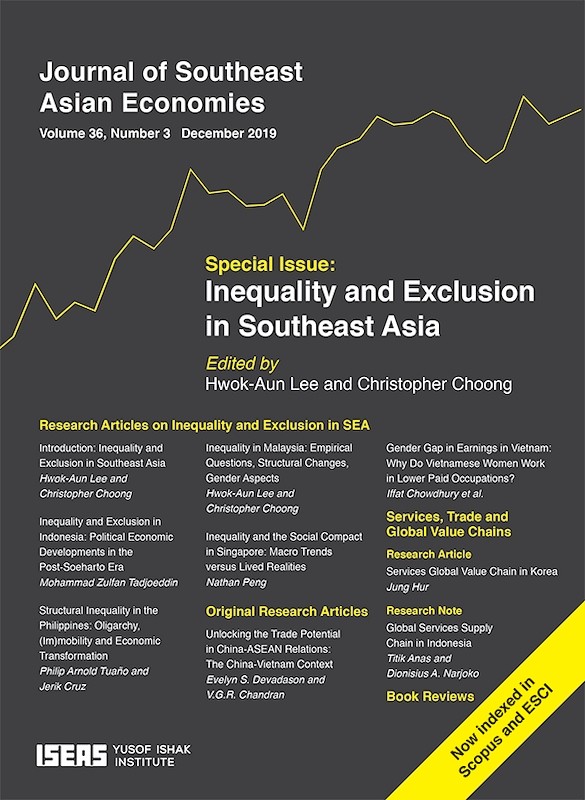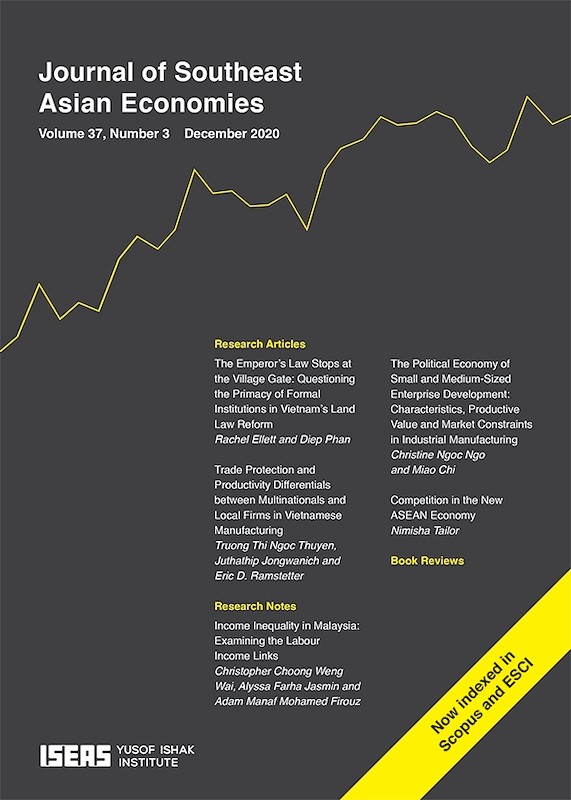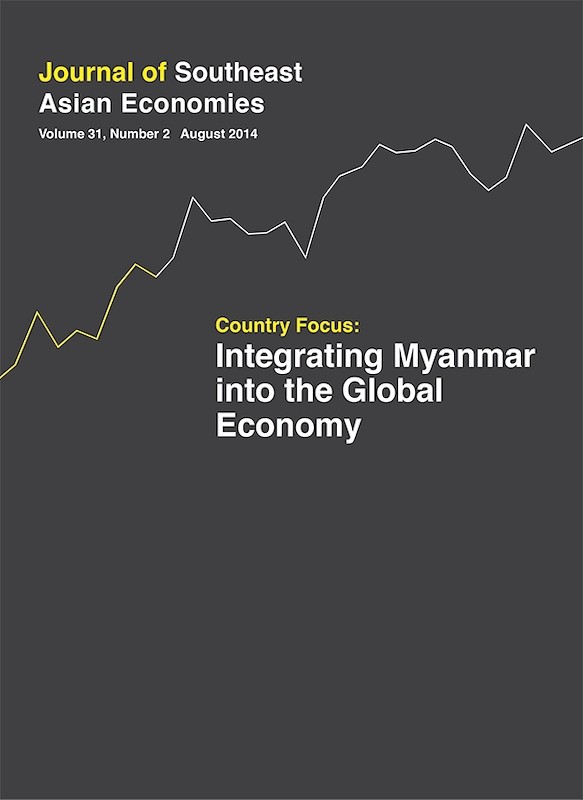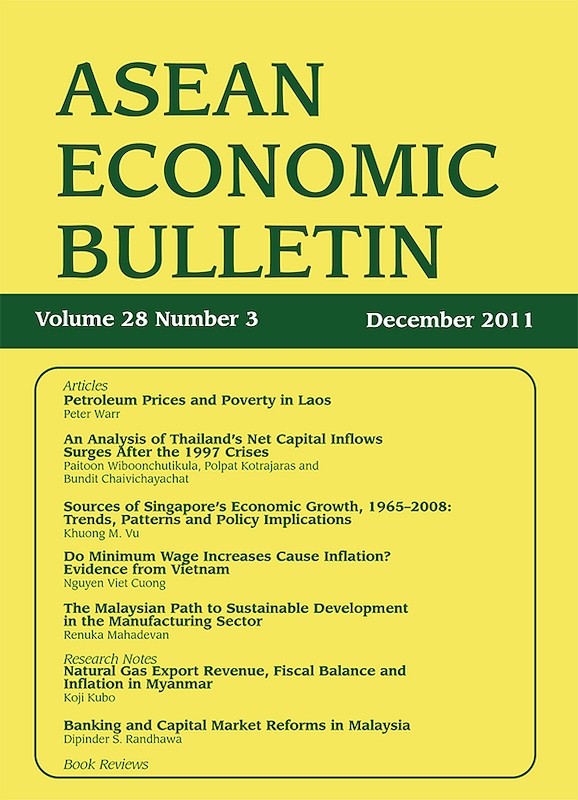Journal of Southeast Asian Economies Vol. 32/1 (Apr 2015). Country focus on "Vietnam at the Crossroads: The Need for Deeper Structural Reforms"
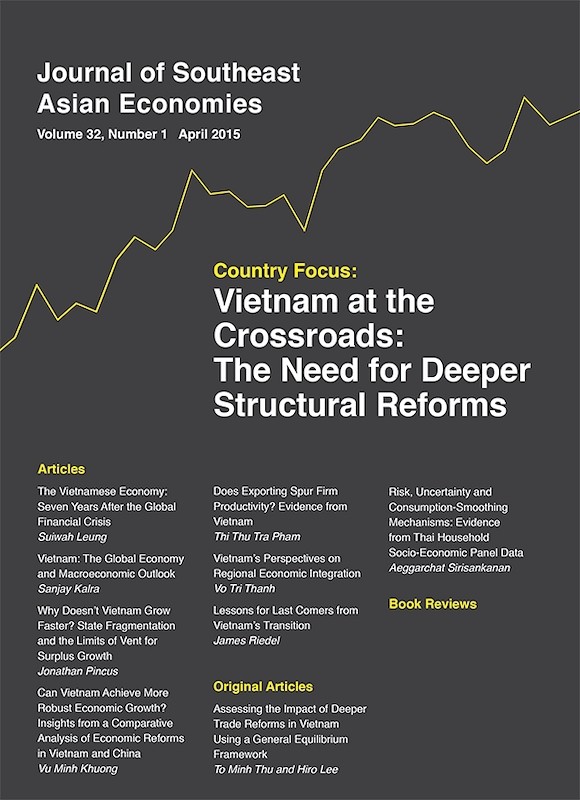
Suiwah Leung, editor
Date of publication:
April 2015
Publisher:
Institute of Southeast Asian Studies
Number of pages:
188
Code:
AE32/1
Contents
-
Journal of Southeast Asian Economies Vol. 32/1 (Apr 2015). Country focus on "Vietnam at the Crossroads: The Need for Deeper Structural Reforms"
[Whole Publication, ISSN: 23395206] -
Preliminary pages
- COUNTRY FOCUS ARTICLES
-
The Vietnamese Economy: Seven Years After the Global Financial Crisis, by Suiwah Leung, author see abstractSeven years after the Global Financial Crisis of 2008, concern with the Vietnamese economy has shifted from short-term issues of inflation and balance of payments to prospects for medium- to longer term economic development. After several tumultuous years, macroeconomic stabilization has been achieved, but growth is significantly below trend, and is heavily dependent on manufactured exports. State-led industrialization has, inter alia, resulted in a lack of “industrial deepening” as well as a low employment-output elasticity. Deep structural reforms, particularly in the financial sector, state-owned enterprises, and public finance and investment are necessary to lift Vietnam’s longer term growth and to provide employment for its relatively young and growing population. Strong political leadership is needed to resist the influence of vested interests. Vietnam is indeed at the crossroads of taking action to join the ranks of the high-income industrialized economies of East Asia in the future or remaining mired in low middle-income status.
-
Vietnam: The Global Economy and Macroeconomic Outlook, by Sanjay Kalra, author see abstractAfter almost a decade of high growth, Vietnam’s growth rate fell during 2011–13. Since 2001, the country has also experienced two bouts of high inflation, booms and busts in equity and real estate markets, and episodes of large capital inflows and outflows. Against the backdrop of the global economy, this paper provides an account of macroeconomic developments in Vietnam during 2011 to 2013, examines the imbalances that came to a head in 2011, the macroeconomic stabilization achieved during 2012 to 2014, and the outlook and challenges going forward. The paper concludes that successfully designing and implementing a broad set of policies — staying the course on macroeconomic stabilization, while accelerating the pace of structural reform significantly, and integrating into the global economy — will allow Vietnam to further advance the remarkable gains that it has already made in poverty alleviation and achieving its Millenium Development Goals.
-
Why Doesnt Vietnam Grow Faster? State Fragmentation and the Limits of Vent for Surplus Growth, by Jonathan Pincus, author see abstractAlthough Vietnam has achieved exceptionally rapid growth of exports, “vent-for-surplus” production of agricultural commodities and labour-intensive manufactures has yet to stimulate the development of large-scale, technologically progressive firms. Foreign-invested and small domestic enterprises still dominate and rely heavily on imports of intermediate and capital goods. The absence of upstream and downstream industries can be explained at least in part by Vietnam’s unique transition from central planning. The state has not receded from economic life as much as reconfigure itself to benefit from market opportunities. Commercialization of the state has aggravated the long-standing problem of fragmentation, which has blocked government efforts to impose discipline on state agencies and enforce central government plans and regulations.
-
Can Vietnam Achieve More Robust Economic Growth? Insights from a Comparative Analysis of Economic Reforms in Vietnam and China, by Khuong Vu, author see abstractThis paper conducts a comparative analysis of economic reforms in Vietnam and China to gain insights into critical reform areas that are imperative for Vietnam to achieve more robust economic growth. This study finds that the growth gap between the two countries has been substantial not only for GDP but also for labour productivity and total factor productivity, both of which are essential for sustainable economic performance in the long term. The main causes behind the growth disparity between Vietnam and China are governance-related factors, namely government effectiveness, regulatory quality, administrative reforms, state-owned enterprise reforms and policy experimentation efforts, along with induced elements such as education and technological upgrading. While China’s stronger performance does not imply that Vietnam should embrace the former’s growth model, the considerable performance gap between the two countries suggests that Vietnam has great potential to accelerate its own economic growth. The insights and discussion from this study indicate that Vietnam can achieve far more robust growth if it launches a new wave of reforms to effectively strengthen the aforementioned factors. This paper provides a suite of relevant and actionable policy recommendations for Vietnam to embark on this endeavour.
-
Does Exporting Spur Firm Productivity? Evidence from Vietnam, by Thi Thu Tra Pham, author see abstractThis study uses data on Vietnamese manufacturing firms from the World Bank Enterprise Surveys for the period 2002–08 to examine causality between export participation and firm productivity. The analysis focuses on the three hypotheses related to the relationship between exporting and firm productivity that have received attention in the literature, namely: self-selection; learning-by-exporting; and core competence hypotheses. In this case study, evidence is found in support each of these hypotheses, which are often portrayed as competing with each other but are in fact complementary. It is found that comparative advantage, which in the case of Vietnam — a labour-abundant, low-wage country — is in labour-intensive products, is central to understanding each of the three hypotheses. The firms that have relatively high productivity (ex ante) and accordingly self-select to export are those that produce in line with Vietnam’s comparative advantage (i.e., firms that are relatively labour-intensive). Firms that experienced a relatively large increase in export intensity are found to have experienced higher total factor productivity, supporting the learning-by-exporting hypothesis, and a relatively large increase in labour intensity, supporting the core competence hypothesis and the central role of comparative advantage.
-
Vietnam's Perspectives on Regional Economic Integration, by Vo Tri Thanh, author see abstractThis paper revisits Vietnamese perspectives on regional economic integration. Proactive economic integration has been an important pillar of Vietnam’s economic reforms. The country’s current economic integration process involves preparation for the ASEAN Economic Community (AEC) and the negotiation of ambitious free trade agreements such as the Trans-Pacific Partnership (TPP) and Regional Comprehensive Economic Partnership (RCEP) agreements. As the umbrella organization for Vietnam’s economic integration, ASEAN continues to forge the country’s trade and investment linkages with the region. The AEC is making progress, but certain challenges remain with the overall management of regional cooperation, improvements to ASEAN centrality and connectivity, and issues related to contemporary regional and non-traditional security. RCEP and TPP represent recent ambitious efforts to promote economic integration. Notwithstanding their potential benefits, RCEP and TPP may produce different outcomes, including trade diversion, for major economies. These two trade agreements have various similarities and differences, but they exhibit potential consistency with the concept of a Free Trade Area of the Asia Pacific. Vietnam’s economy may benefit immensely from ongoing integration efforts. Still, such benefits are conditional on relevant and timely domestic reforms, particularly of economic institutions, state-owned enterprises and public investment. The harmonization of commitments under various economic integration tracks and improvements to market confidence is also critical.
-
Lessons for Last Comers from Vietnam's Transition, by James Riedel, author see abstractWhat lessons can last comers, like North Korea and Myanmar, and the aid community that stands ready to assist them, learn from the experience of Vietnam? What motivated Vietnam to abandon Soviet-style central planning for a market economy (albeit one with a socialist orientation)? Did foreign technical assistance play an important role in designing and assisting in the implementation of the reforms that have propelled growth in Vietnam? Does Vietnam’s experience support or contradict the increasingly fashionable view that institutional change is a prerequisite to successful economic reform? Can a country, such as North Korea, emulate the transition experience of Vietnam and expect similar success?
- ORIGINAL ARTICLES
-
Assessing the Impact of Deeper Trade Reforms in Vietnam Using a General Equilibrium Framework, by To Minh Thu, Hiro Lee, authors see abstractVietnam is currently undertaking deeper trade liberalization, both by reducing tariffs and introducing reforms in other trade-related areas. In this paper, the impact of Vietnam’s trade reforms on its economic welfare and sectoral adjustments are assessed using a dynamic computable general equilibrium (CGE) model. We consider the effects of goods and services trade liberalization, an increase in foreign direct investment inflows, a reduction in administrative and technical barriers to trade, and a reduction in trade and transport margins. When all effects are combined, Vietnam’s economic welfare is projected to increase by 8.4 per cent in 2020 compared to the baseline. Many manufacturing sectors would expand, whereas agricultural, minerals and fuel sectors would contract. The output expansion is most significant in the textiles and wearing apparel sector.
-
Risk, Uncertainty and Consumption-Smoothing Mechanisms: Evidence from Thai Household Socio-Economic Panel Data, by Aeggarchat Sirisankanan, author see abstractThis paper examines the consumption-smoothing mechanisms of Thai agricultural households using data from the Thai household socio-economic panel surveys conducted from 2005 to 2007. The study finds that households heavily depend on their saving mechanisms when smoothing their consumption in the face of an income shock. There is little evidence to show that households depend on borrowing and increased work hours to counteract income shocks. The results also show that savings have a positive significant relationship with income variance in every region, whereas households do not respond to future income uncertainty by borrowing or increasing work hours in all regions.
- BOOK REVIEWS
-
BOOK REVIEW: Clusters and Economic Growth in Asia, edited by Sören Eriksson. , by Leo van Grunsven, author
-
BOOK REVIEW: Energy Market Integration in East Asia: Deepening Understanding and Moving Forward, edited by Yanrui Wu, Fukunari Kimura and Xunpeng Shi. , by Pami Aalto, author
-
BOOK REVIEW: The State and the Advocate: Case Studies on Development Policy in Asia, by Teresita Cruz-del Rosario. , by Juan Zhang, author
-
BOOK REVIEW: Health Insurance Reforms in Asia, by Sabrina Luk. , by Nopphol Witvorapong, author
-
BOOK REVIEW: Dreaming of Money in Ho Chi Minh City, by Allison Truitt. , by Benjamin Loh, author

